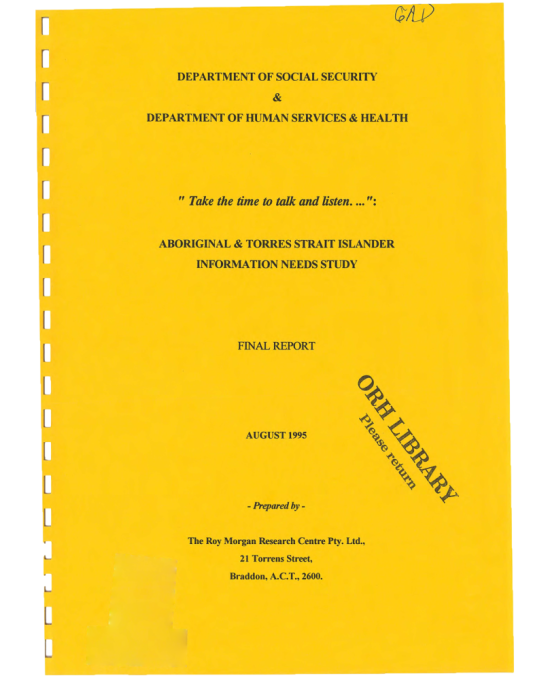
Study finds government communication lacking
A study into communication preferences among Aboriginal and Torres Strait Islander communities showed DSS needed to better account for community needs.
... respondents repeated ... not being listened to ... or dealing with imposed solutions ... which fail to address and meet their real needs and aspirations.
| Attachment | Size |
|---|---|
| dss-dhsh-information-needs-report.pdf | 5.52 MB |
| Attachment | Size |
|---|---|
| dss-dhsh-information-needs-plaintext.docx | 466.08 KB |
In 1995, the government ran a study into how Aboriginal and Torres Strait Islander people reacted to messaging about government payments and programs. These excerpts show some of the findings and recommendations.
To complete the study, researchers conducted 900 face-to-face interviews with Aboriginal and Torres Strait Islander people in 70 communities. The researchers also held discussions and focus groups with people who worked in roles delivering health and welfare services.
Questions about the government’s communication style
Interviewers asked about how people reacted to the communication style used by the Department of Social Security (DSS). People said they found DSS’s written communication confusing and preferred to talk to someone in person. However, they found DSS’s offices unwelcoming and ‘harsh’. They said Aboriginal Liaison Officers were usually helpful, but they were in high demand.
The study found that not many people knew details about the help they could get. Many Aboriginal and Torres Strait Islander people had negative perceptions of government departments. This meant that communicating government services in a way that was both clear and inviting for audiences was a difficult task.
People said they preferred TV and radio ads to information in newspapers. They said they liked specially designed posters with Aboriginal and Torres Strait Islander designs and that they preferred clear and direct language.
People surveyed had positive responses to the ‘Top-up money for kids’ booklet, which was colourful and easy to understand (1995:92–102).
Recommendations to improve communication
The report recommended the government develop communication in consultation with the communities they were trying to reach. The report authors said that all communication needed to reflect local community needs, values and priorities.
For ‘information products’ it was suggested to use less dense written material and to use engaging mediums like TV and radio more.
The report also recommended the government work more collaboratively across departments, communities and community organisations. It said they should include locals in planning, decision-making and action.
It suggested more Aboriginal Liaison Officers on the ground, but also improved training and support for all DSS staff, which would help DSS to better serve communities.
Many of the recommendations echoed what Aboriginal and Torres Strait Islander staff had been asking DSS for.
Promoting recommendations to staff
As part of DSS’s news video program called Communiqué, a summary of the study’s findings was presented to inform staff.
In this video, DSS Research Officer Craig Young says most customers want face-to-face contact. He says messages in writing should use clear language and local photos. He also says local people should help to produce the messages if possible.
The report and follow-up video show how DSS was continuing to improve their communication styles to better meet the needs of Aboriginal and Torres Strait Islander customers. The report is an example of DSS seeking out detailed information to improve their services.
DSS and the Department of Human Services and Health worked with Ray Morgan Research on the report.
This copy of the report is from the Department of Social Services Library.
The Communiqué program was broadcast monthly by the Communications area in DSS through closed network satellite services. It was viewed by staff in dedicated rooms set up for interactive training sessions.
Permissions
Permissions to include the video excerpts here were granted by Craig Young and Dan Marsden.
Citations
Department of Social Security and Department of Human Services and Health (1995) ‘Take the time to talk and listen ...’: Aboriginal and Torres Strait Islander needs study, report to the Australian Government Department of Social Security and the Department of Human Services and Health, Roy Morgan Research Centre, Canberra.
Department of Social Security (1995) ‘Information needs study’, Communiqué [video], Corporate Television Unit, Department of Social Security, Canberra.
